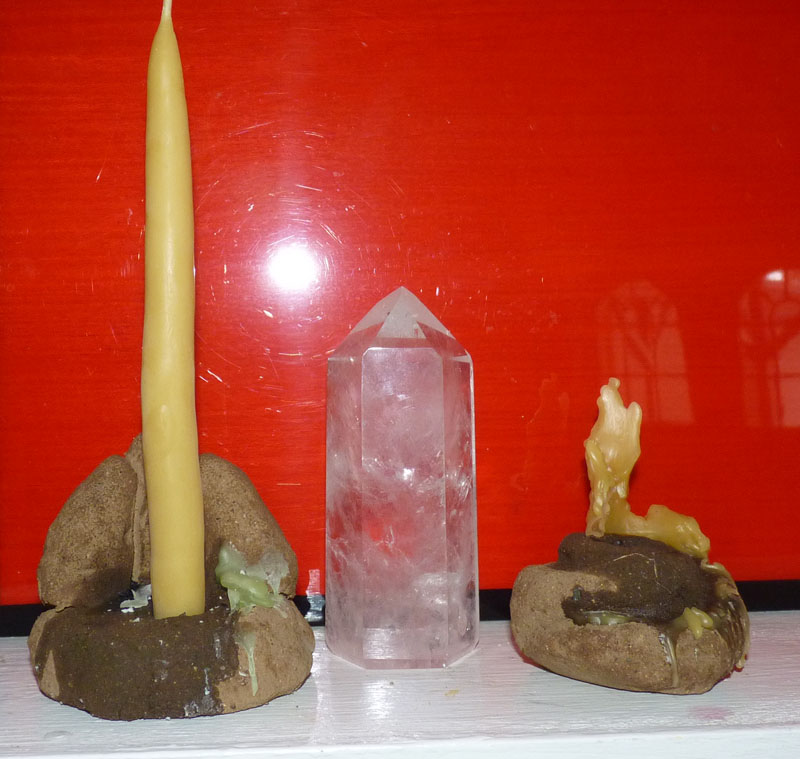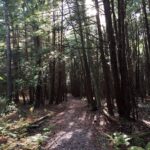In my quest for sustainable items for ritual and mundane purposes, I want to share something that I learned at the Strawbale Studio‘s recent workshop on natural, earth-friendly gifts: cob / earthen candle holders, paperweights, and other useful cob objects. The best thing about this project is that, other than some manual labor (and maybe a sifter, if you don’t have one) these materials can come 100% from your backyard.

Here’s how you go about making yourself some earthen candle holders.
Test your soil and get some sand and clay. Cob is an ancient building material made of the substrate of soil–specifically, a mix of sand and clay. A good cob mix has about 10-25% clay and the remaining parts sand, with only a little silt (not more than 5-10%). You can tell if you have a good cob mix by digging down till you get below the top soil (usually a foot or more, you’ll be able to see the line of black hummus vs. what is underneath) and then filling a mason jar 75% of the way with the sub-soil (broken up) and then adding water. Shake the jar up and sit it down on a flat surface. What immediately falls to the bottom is sand. What falls within the next 30 or so minutes is silt, and what falls over the next 24 hours (as you let it sit still) is clay. A good cob mix will be sticky and hold together well. I tested my soils while I was planting trees. It took a bit of searching till I was able to find clay (my soil apparently has a ton of silt and sand). I ended up not finding clay in any of my holes I dug for trees but instead down on the banks of my pond. So to make my cob, I have to mix sand from one part of my yard and clay from another. If you can’t find one of your ingredients–ask around. Chances are, someone nearby has too much sand or too much clay :).
Screen your cob. Once you have a good cob mix, you want to screen it. You can make a simple screen by using hardware cloth and stapling it to a frame. Then you just sift the cob mix through the screen. 1/8″ or 1/4″ is a good size so that you aren’t going to be stuck with big rocks.
Wet your cob mix. Now that you have some screened cob, you can add water enough to make it form into an earthen ball. It shouldn’t be so wet that it goes goopy. At this point, if you want to add something to stabilize it and give it more strength, you can do that. Finely chopped straw or cut grass (dried) will work well. At our workshop, we actually added a wheat glue (it was just wheat + boiling water, which got soupy). It held together well!

Shape your cob candle holders or other objects. I had a good time making some earthen candleholders for my beeswax candles. You shape these like you would any other clay, but recognize that cob isn’t able to hold the fine detail like pure clay can; it can still take basic shapes and imprints. One of the candleholders cracked really bad, and based on my knowledge of pottery, I think it may have dried out too fast because I had it sitting near my stove to dry out. But the other three were great. Our group made all sorts of candle holders–turtles and spirals and leaves.
Let them dry. My cob candleholders took over a week to dry. When they were dry though, they were very tough. Obviously, these aren’t fired, so if you get them wet, they are going to fall apart. But they work great indoors or outdoors if they are kept dry.
Use them! In using the candleholders with my beeswax candles (directions for how to make them here), I found that the beeswax, when melted, kinda seeps into the earthen candleholder and darkens it a bit. I have no problem with this, but it is something to take note of. The cob candleholders, overall, worked wonderfully!



no offense, but your “cob” looks a bit like dog poo.
Its dirt, lol. And poo is sacred too…this was my very first blog post!
https://druidgarden.wordpress.com/2010/10/29/holy-shit/
Once the ground becomes a little softer, I think I will try this! Thanks!
I wonder if a coating of paint of some kind, or even the beeswax that it absorbs as it melts, might make it more resilient in the wet.
[…] learned a great deal of information on more sustainable living skills, such as cob building and artwork, strawbale construction and natural building, growing mushrooms, barn raising, rocket stoves, […]